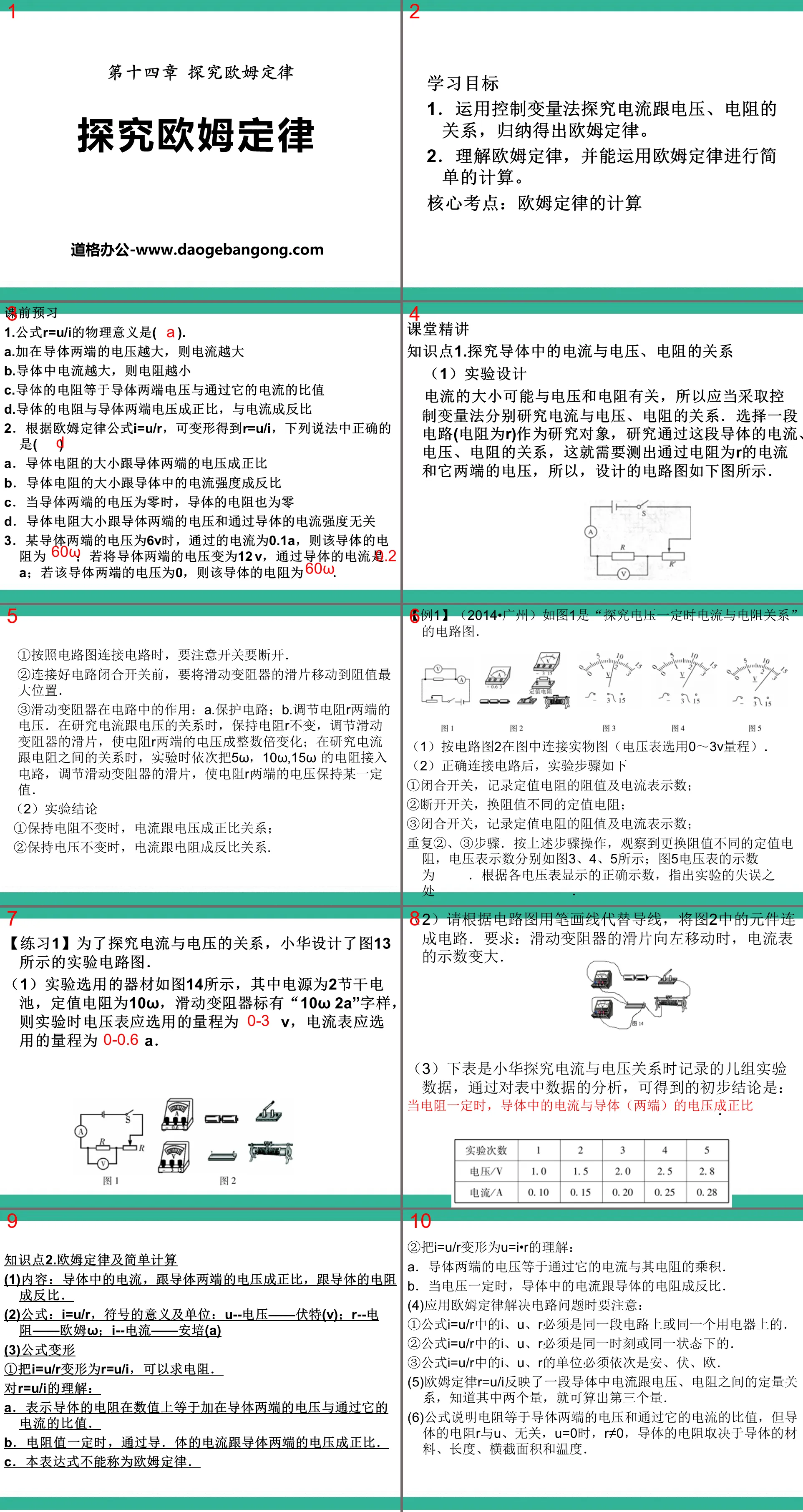People's Education Edition Physics for Grade 8, Volume 2
People's Education Edition Physics for Grade 8, Volume 1
People's Education Edition Ninth Grade Physics Complete Book
Shanghai Science Edition Ninth Grade Physics
Shanghai Science Edition 8th Grade Physics
Beijing Normal University eighth grade physics volume one
Lu Jiao Edition Ninth Grade Physics Volume 2
Beijing Normal University Ninth Grade Physics Volume 1
Lu Ke Edition High School Physics Compulsory Course One
Lu Jiao Edition Ninth Grade Physics Volume 1
Guangdong and Shanghai Edition Ninth Grade Physics Volume 1
People's Education Press High School Physics Compulsory Course II
Beijing Normal University Ninth Grade Physics Volume 2
Lu Jiao Edition Eighth Grade Physics Volume 2
Lu Jiao edition eighth grade physics volume 1
Guangdong and Shanghai Edition Ninth Grade Physics Volume 2

| Category | Format | Size |
|---|---|---|
| Guangdong and Shanghai Edition Ninth Grade Physics Volume 1 | pptx | 6 MB |
Description
"Exploring Ohm's Law" PPT courseware
learning target
1. Use the controlled variable method to explore the relationship between current, voltage, and resistance, and summarize Ohm's law.
2. Understand Ohm's Law and be able to use Ohm's Law to perform simple calculations.
Core test point: Calculation of Ohm’s law
Preview before class
1. The physical meaning of the formula R=U/I is ( ).
A. The greater the voltage applied across the conductor, the greater the current
B. The greater the current in a conductor, the smaller the resistance
C. The resistance of a conductor is equal to the ratio of the voltage across the conductor to the current flowing through it.
D. The resistance of a conductor is directly proportional to the voltage across the conductor and inversely proportional to the current
2. According to Ohm's law formula I=U/R, it can be deformed to get R=U/I. The correct one of the following statements is ( )
A. The resistance of a conductor is proportional to the voltage across the conductor
B. The resistance of a conductor is inversely proportional to the intensity of the current in the conductor
C. When the voltage across a conductor is zero, the resistance of the conductor is also zero
D. The resistance of a conductor has nothing to do with the voltage across the conductor and the intensity of the current passing through the conductor.
3. When the voltage across a conductor is 6V, the current flowing through it is 0.1A, then the resistance of the conductor is ________; if the voltage across the conductor is changed to 12 V, the current through the conductor is ________A; if the voltage across the conductor is is 0, then the resistance of the conductor is ________.
Lectures in class
Knowledge point 1. Explore the relationship between current, voltage and resistance in a conductor
(1) Experimental design
The size of the current may be related to voltage and resistance, so the controlled variable method should be used to study the relationship between current, voltage, and resistance respectively. Select a section of circuit (resistance R) as the research object to study the relationship between current, voltage, and resistance passing through this section of conductor. This requires measuring the current passing through the resistance R and the voltage at both ends. Therefore, the designed circuit diagram is as follows shown.
① When connecting the circuit according to the circuit diagram, be sure to turn off the switch.
② Before connecting the circuit and closing the switch, move the sliding piece of the sliding rheostat to the position of maximum resistance.
③The role of the sliding rheostat in the circuit: a. Protect the circuit; b. Adjust the voltage across the resistor R. When studying the relationship between current and voltage, keep the resistance R constant and adjust the slide of the sliding rheostat so that the voltage at both ends of the resistor R changes by an integer multiple; when studying the relationship between current and resistance, during the experiment, change 5Ω, A 10Ω or 15Ω resistor is connected to the circuit and the slider of the sliding rheostat is adjusted to keep the voltage across the resistor R at a certain value.
(2) Experimental conclusion
①When the resistance is kept constant, the current is proportional to the voltage;
②When the voltage is kept constant, the current is inversely proportional to the resistance.
Knowledge point 2. Ohm’s law and simple calculations
(1) Content: The current in a conductor is directly proportional to the voltage across the conductor and inversely proportional to the resistance of the conductor.
(2) Formula: I=U/R, the meaning and unit of the symbol: U--Voltage-Volt (V); R--Resistance-Ohm Ω; I--Current-Ampere (A)
(3)Formula deformation
① Transform I=U/R into R=U/I, and you can find the resistance.
Understanding of R=U/I:
a. The resistance of a conductor is equal to the ratio of the voltage across the conductor to the current flowing through it.
b. When the resistance value is constant, through the conductor. The current in a body is proportional to the voltage across the conductor.
c. This expression cannot be called Ohm's law.
②The understanding of transforming I=U/R into U=I·R:
a. The voltage across a conductor is equal to the current through it multiplied by its resistance.
b. When the voltage is constant, the current in the conductor is inversely proportional to the resistance of the conductor.
(4) When applying Ohm’s law to solve circuit problems, please pay attention to:
①I, U, and R in the formula I=U/R must be on the same circuit or on the same electrical appliance.
②I, U, and R in the formula I=U/R must be at the same time or in the same state.
③The units of I, U, and R in the formula I=U/R must be Amperes, Volts, and Ohms in order.
(5) Ohm's law R=U/I reflects the quantitative relationship between current, voltage and resistance in a conductor. If you know two of the quantities, you can calculate the third quantity.
(6) The formula states that the resistance is equal to the ratio of the voltage at both ends of the conductor to the current passing through it, but the resistance R of the conductor has nothing to do with U. cross-sectional area and temperature.
In-class testing
1. (2014·Hohhot) It can be known from the Ohm’s law formula ( )
A. The voltage across a conductor is inversely proportional to the current through the conductor
B. When the voltage across a conductor is zero, the resistance of the conductor is zero because no current is flowing through it.
C. The greater the current in a conductor, the smaller the resistance of the conductor
D. The resistance of a conductor can be expressed by the ratio of the voltage across it to the current passing through it.
2. (2014·Shantou) As shown in the figure is the U�I relationship diagram obtained by measuring the voltage and current passing through the fixed-value resistor R and the small light bulb L respectively. It can be seen from the figure that the resistance of the fixed-value resistor R is _____Ω; the resistance of the small light bulb L will gradually change as the voltage across it increases. When the voltage across it is 2V, the resistance is _____Ω.
3. The ratio of the two resistors is R1:R2=2:5. When they are connected in series in a circuit, the ratio of the currents passing through them is ______, and the ratio of the voltages at both ends is ______; if they are connected in parallel In a circuit, the ratio of the currents passing through them is ______, and the ratio of the voltages across them is ______.
4. Xiaojun used the circuit as shown in the picture to study "the relationship between the current passing through a conductor and its resistance." He conducted two experiments with resistors of 5Ω and 10Ω respectively. After completing the first experiment, Xiaojun combined A, The resistance R between two points B is changed from 5Ω to 10Ω. After closing the switch, it is found that the voltmeter indicates ______. In order to keep the voltage across R unchanged, he should move the slider of the sliding rheostat ____________ ("move to the left" ”, “Move to the right” or “Keep unchanged”)
Keywords: Exploring Ohm's Law teaching courseware, Guangdong and Shanghai version ninth grade physics PPT courseware download, ninth grade physics slide courseware download, Exploring Ohm's Law PPT courseware download, .PPT format;
For more information about the "Exploring Ohm's Law" PPT courseware, please click the "Exploring Ohm's Law" ppt tag.
"Application of Ohm's Law" Exploring Ohm's Law PPT Courseware 3:
"Application of Ohm's Law" Exploring Ohm's Law PPT Courseware 3 1. Measure resistance by voltammetry 1. Principle: Ohm's law I=U/R deformation formula R=U/I 2. Equipment: power supply, switch, voltmeter, ammeter, sliding rheostat, small light bulb and some wires. 3. experiment..
"Application of Ohm's Law" Exploring Ohm's Law PPT Courseware 2:
"Application of Ohm's Law" Exploring Ohm's Law PPT Courseware 2 Learning Objectives 1. Learn to measure resistance using voltammetry. 2. Be able to use Ohm's law to analyze practical problems such as the hazards of short circuits. 3. By using Ohm's law measurement and analysis and discussion, we know that the resistance of the filament varies with...
"Application of Ohm's Law" explores Ohm's Law PPT courseware:
"Application of Ohm's Law" Exploring Ohm's Law PPT Courseware Teaching Objectives. 1. Know how to measure resistance by voltammetry. 2. Be able to analyze the hazards of short circuit. 3. Be able to use Ohm's law to perform simple calculations. There is a resistor with an unknown resistance in the laboratory. How to measure its resistance? ..
File Info
Update Time: 2024-11-20
This template belongs to Physics courseware Guangdong and Shanghai Edition Ninth Grade Physics Volume 1 industry PPT template
"Exploring Ohm's Law" PPT courseware Simple campus recruitment activity planning plan summary enterprise and institution recruitment publicity lecture PPT template is a general PPT template for business post competition provided by the manuscript PPT, simple campus recruitment activity planning plan summary enterprise and institution recruitment promotion Lecture PPT template, you can edit and modify the text and pictures in the source file by downloading the source file. If you want more exquisite business PPT templates, you can come to grid resource. Doug resource PPT, massive PPT template slide material download, we only make high-quality PPT templates!
Tips: If you open the template and feel that it is not suitable for all your needs, you can search for related content "Exploring Ohm's Law" PPT courseware is enough.
How to use the Windows system template
Directly decompress the file and use it with office or wps
How to use the Mac system template
Directly decompress the file and use it Office or wps can be used
Related reading
For more detailed PPT-related tutorials and font tutorials, you can view: Click to see
How to create a high-quality technological sense PPT? 4 ways to share the bottom of the box
Notice
Do not download in WeChat, Zhihu, QQ, built-in browsers, please use mobile browsers to download! If you are a mobile phone user, please download it on your computer!
1. The manuscript PPT is only for study and reference, please delete it 24 hours after downloading.
2. If the resource involves your legitimate rights and interests, delete it immediately.
3. Contact information: service@daogebangong.com
"Exploring Ohm's Law" PPT courseware, due to usage restrictions, it is only for personal study and reference use. For commercial use, please go to the relevant official website for authorization.
(Personal non-commercial use refers to the use of this font to complete the display of personal works, including but not limited to the design of personal papers, resumes, etc.)
Preview










